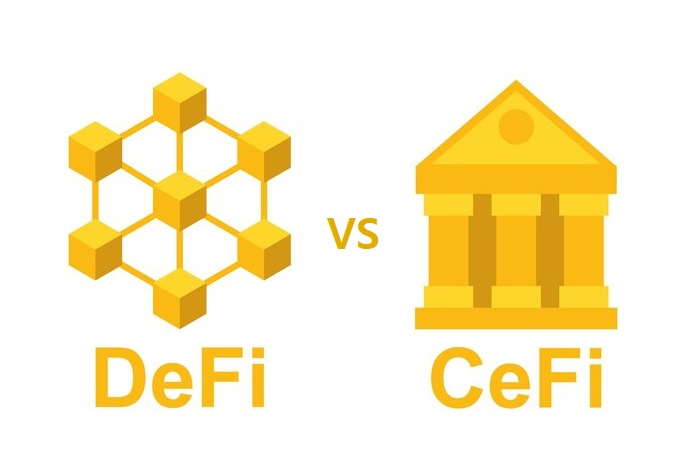
The landscape of financial services, encompassing payments, lending, and borrowing, once solely revolved around established financial institutions and banks. However, the emergence of blockchain technology dramatically altered this paradigm. As the cryptocurrency realm expanded, it led to a significant shift in focus towards two distinct realms: Decentralized Finance (DeFi) and Centralized Finance (CeFi). In this article, we will explore and compare these two financial paradigms, shedding light on their unique features and advantages.
Exploring Decentralized Finance (DeFi)
Unlike CeFi, DeFi operates without the involvement of a centralized exchange. Instead, it relies on automated applications built on blockchain platforms. DeFi aims to establish a transparent and inclusive financial system that enables even unbanked individuals to access financial services through blockchain technology. This open-source, permissionless ecosystem offers a wide range of services, including borrowing, yield farming, crypto lending, and asset storage. One of the most significant advantages of DeFi is the ownership and control it grants users over their assets. In DeFi, users access services through decentralized applications (dApps) built on blockchain platforms, further enhancing transparency and accessibility.
Understanding Centralized Finance (CeFi)
Before the advent of DeFi, Centralized Finance (CeFi) held sway as the dominant force in crypto trading. CeFi maintained a stronghold over the cryptocurrency industry, with all crypto trade orders funnelled through a central exchange. These central exchanges were responsible for managing user funds and dictated the terms of trading. When you engage in trading through a centralized exchange, you relinquish ownership of a private key necessary for wallet access. Additionally, central exchanges have the authority to decide which coins are listed for trading and impose trading fees. In essence, when participating in CeFi, you don't have full control over your cryptocurrencies, and you are subject to the rules set by the centralized exchange.
Comparing DeFi and CeFi
The choice between DeFi and CeFi often comes down to whether users prefer to trust technology or people. In the case of DeFi, users place their trust in the reliability of the technology to perform as intended. In contrast, CeFi relies on trust in the individuals or businesses managing funds and providing services. Both DeFi and CeFi offer a wide array of cryptocurrency-related financial services. Let's delve into some of the distinguishing features and functionalities of these two ecosystems.
Features of CeFi
1. Centralized Exchange (CEX)
CeFi operates through traditional cryptocurrency exchanges like Binance, Kraken, or Coinbase. Users deposit their funds into these exchanges, but these funds are held outside of the users' direct custody. While central exchanges often provide a high level of customer support, the security of users' funds is contingent on the exchange's security measures. This centralized approach has made these exchanges vulnerable to security breaches.
2. The Flexibility of Fiat Conversion
CeFi offers greater flexibility when converting between fiat and cryptocurrency. Onboarding customers into the CeFi ecosystem is convenient and provides a seamless customer experience. This is particularly advantageous for users who want to transition between traditional and digital currencies.
3. Cross-chain Services
CeFi services support trading various cryptocurrencies issued on independent blockchain platforms. This is in contrast to DeFi services, which do not support cross-chain swaps due to their inherent complexities. CeFi can facilitate such trades by taking custody of funds from multiple chains, a valuable feature for users dealing with a diverse range of cryptocurrencies.
Features of DeFi
1. Permissionless
DeFi stands out for its permissionless nature. Users can access DeFi services without undergoing a Know Your Customer (KYC) process, eliminating the need to share personal information or make initial deposits. DeFi is openly accessible to all parties, fostering inclusivity and collaboration within the community. It encourages the development of products that benefit each other, often referred to as "money legos."
2. Trustless
One of the most significant advantages of DeFi is the absence of the need to trust that services will perform as advertised. Users can independently verify DeFi services by auditing their code and utilizing external tools like Etherscan to confirm the accuracy of transactions.
3. Quick Innovation
DeFi thrives on rapid innovation within the decentralized financial ecosystem. It continually introduces new capabilities and experiments with novel features. This innovative nature has given rise to a diverse range of financial services that aim to address the shortcomings of centralized financial systems.
Real-World Use Cases
Some Real Use Cases of CeFi
• Coinbase: A cryptocurrency exchange that facilitates trading, borrowing, margin trading, native stablecoin, lending, payments, and more.
• Fairlay: A Bitcoin Prediction Market and Exchange following the CeFi model.
• BlockFi: A platform for cryptocurrency and fiat borrowing and lending.
• Celsius: A cryptocurrency borrowing, payments, and lending platform.
• Ledn: An insured Bitcoin to DAI borrowing and lending platform.
• Libra: A global financial infrastructure and cryptocurrency layer.
Some Real Use Cases of DeFi
• Totle: An aggregator of decentralized liquidity with automatic price optimization.
• Augur: A decentralized predictions market.
• Nexus Mutual: A decentralized insurance tool.
• Kyber: A decentralized exchange.
• MakerDAO: A decentralized platform for stablecoin minting and lending.
• bZx: A decentralized lending and margin trading platform.
Conclusion
Both Centralized Finance (CeFi) and Decentralized Finance (DeFi) share a common goal of popularizing crypto trading and enhancing trading volume. However, the paths they take to achieve these objectives differ significantly. CeFi prioritizes the security of funds and ensures fair trade, making it accessible even to those with conventional currencies. It offers robust customer support services, instilling confidence in its users. In contrast, DeFi seeks to create a space free from intermediaries, empowering investors to execute their strategies independently.
Both models have their merits and demerits, and the choice between them ultimately depends on individual preferences and needs. If transparency and privacy are paramount, DeFi is the ideal choice. On the other hand, for those who value trust, risk sharing, flexibility, and a broader spectrum of investment options, CeFi remains the more suitable option.